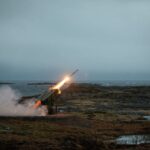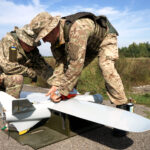BERLIN – Friedrich Merz picked up the phone on Thursday and asked U.S. President Donald Trump for one thing: more Patriot air-defense systems for Kyiv. The conversation lasted roughly twenty minutes and focused on securing additional batteries against a backdrop of tightened U.S. stockpiles.
A government aide later confirmed that Merz initiated the call after an internal review showed that Ukraine’s current Patriot inventory will not cover the summer offensive season. Spiegel first reported the approach; officials in Berlin say the chancellor wanted a direct read-out from Trump rather than channeling the request through lower-level staff.
Urgent Demand for Patriot Missile Systems in Ukraine’s Air Defense
Washington’s willingness matters because the Pentagon froze at least thirty Patriot interceptors and several other precision weapons earlier this week while it checks reserve levels. That pause, first detailed by POLITICO, created a short-term gap in Ukraine’s layered air defense.
Berlin now weighs a workaround: buy ready-to-ship Patriots in the United States, fly them to Germany for refit, and hand them to Kyiv without delay. Senior officials say the Bundeswehr is mapping out flight paths and customs clearances so the first battery can move within weeks if Trump signs an export waiver. Germany is in talks to buy Patriots on the commercial market to fill the shortfall created by the U.S. production pause.
Ukraine’s need is clear. The withheld U.S. tranche alone equals a full month of engagement capability for one Patriot battalion. Kyiv fears the hole will encourage more Russian ballistic strikes, including the swarming drone-missile raid that hit the capital two nights ago.
Technical Overview of Patriot Missile Capabilities Deployed in Ukraine
Patriot characteristics:
- PAC-2 GEM-T interceptor range: 70 km against aircraft, 30 km against missiles.
- PAC-3 MSE interceptor range: 40 km, hit-to-kill, optimized for ballistic threats.
- Battery architecture: one AN/MPQ-65 radar, up to eight launchers, one ECS control shelter.
- Reload cycle: twelve minutes per launcher with trained crew.
Germany already transferred three complete Patriot batteries from its own stocks in 2023 and 2024. Federal figures put the cumulative military aid package at €38 billion, second only to the United States. Defense analysts in Berlin add that another €3 billion is reserved in the 2025 supplemental budget for follow-on missile purchases.
Defense Minister Boris Pistorius plans to fly to Washington later this month. His agenda includes talks at Raytheon’s Andover plant and at Lockheed Martin’s PAC-3 line in Camden, Arkansas. He will also press the Pentagon to expedite the approval of foreign military sales for allied pass-through deals. The growing air-defense deal volume reflects similar procurement trends among U.S. allies, such as Australia’s recent AMRAAM acquisition.
Industry contacts say Raytheon can surge production by eight launchers per quarter if overtime shifts continue through December. Lockheed Martin expects a twenty-percent jump in PAC-3 MSE output this year after a record 2024 run. Both companies flag the need for long-lead electronic components, but neither views them as show-stoppers.
Berlin’s acquisition playbook:
- Redirect U.S. Army training stocks held in Germany.
- Lease idle batteries from the Netherlands and Spain.
- Convert Qatar’s soon-to-be-retired PAC-2 units if Doha agrees.
- Tap a dormant South Korean option negotiated in 2022.
Defense officials confirm that NATO has circulated a questionnaire asking each member to list spare Patriot components, including generators and engagement control stations, that could ship inside thirty days. Responses are due at the July 10 Paris support conference. Recent deployments of Dutch and Norwegian F-35s also aim to secure Ukraine supply lines from potential disruptions in Poland and eastern Europe.
Kyiv, meanwhile, keeps up direct pressure. President Volodymyr Zelenskyy spoke with Trump on Friday morning and argued that another Russian drone barrage could force rolling blackouts across central Ukraine if fresh interceptors do not arrive soon. Trump told reporters the call was “meaningful” but offered no timeline on a final decision.
Military liaison officers in Poland relay that the strike pattern around Kyiv has shifted toward mixed salvos – Shahed drones first, followed by Iskander-M missiles. That tactic aims to saturate radar screens and empty ready launchers before the higher-speed missiles arrive. Patriot remains the only fielded system in Ukrainian service that can track and intercept both threat types at once. Adding complexity, the discovery of new F‑35 deficiencies underscores just how critical layered air defense is.
Patriot Missile Deliveries and Impact on Ukraine Conflict
Our analysis shows that if Germany manages to source two complete batteries on the commercial market, Ukraine could deploy them before mid-September. A fresh production run would push delivery into 2026 because radar arrays and canisterized launchers are bottleneck items.
Financing looks feasible. In March, the Bundestag loosened debt-brake rules for defense projects, opening a ten-year €1-trillion window for security and infrastructure spending. Roughly €60 billion of that pool is earmarked for short-cycle weapons replenishment.
According to industry sources, Berlin is prepared to pay the full procurement cost up front and seek partial reimbursement from the European Peace Facility later. That mechanism lowers the administrative burden for Washington, which would only issue an export license.
Berlin also hopes that a visible Patriot hand-off will signal European capacity to backfill U.S. shortfalls. Officials argue that tangible steps boost alliance credibility more than summit communiqués. No European capital has publicly opposed the plan.
Trump’s aides acknowledge that releasing stored Army batteries could draw down U.S. homeland coverage for a period of several months. However, the White House is reviewing a proposal to rotate National Guard crews into Europe for joint training, a move that would offset readiness concerns.
Merz’s office has not disclosed how many Patriot launchers Berlin hopes to secure, only that the initial request covers “the equivalent of two battalions.” Analysts estimate that figure at sixteen to twenty-four launchers plus spare parts and between 120 and 160 interceptors.
Defense officials in Kyiv view the German push as a hedge against an extended U.S. policy review. They also note that every Patriot battery added in Europe frees up medium-range systems, such as NASAMS, to move closer to the front line.
The procurement timeline now hinges on three milestones: Trump’s export waiver, U.S. Army sign-off on temporary divestiture, and Bundestag budget committee approval. Berlin expects quick movement on all three fronts but concedes that any political turbulence in Washington could slow the process.
If the plan stays on track, Ukraine could field a reinforced Patriot umbrella by autumn. That upgrade would blunt Russia’s current missile advantage and buy time for domestic missile production ramp-ups in Europe and the United States. No one in Berlin claims Patriots alone will end the war, yet most agree that every additional launcher narrows Moscow’s options.
REFERENCE SOURCES
- https://www.washingtonpost.com/world/2025/03/18/germany-defense-spending-debt-trump/
- https://www.politico.com/news/2025/07/01/pentagon-munitions-ukraine-halt-00436048
- https://www.bloomberg.com/news/articles/2025-07-04/germany-in-talks-to-ensure-air-defense-deliveries-to-ukraine
- https://www.jpost.com/international/article-860023
- https://www.theguardian.com/world/2025/jul/02/us-halts-ukraine-weapons-shipments
- https://www.defenseone.com/ideas/2023/05/ukraine-another-chance-judge-patriot-missile/386036/
- https://www.reuters.com/world/germanys-merz-held-call-with-trump-ukraine-arms-deliveries-2025-07-04/
- https://www.lockheedmartin.com/en-us/news/features/2025/lockheed-martins-pac-3mse-achieves-record-production-year.html
- https://www.bundesregierung.de/breg-en/federal-government/military-support-ukraine-2054992
- https://www.theguardian.com/world/live/2025/jul/04/europe-live-latest-news-russia-ukraine-war-putin-zelenskyy
- https://www.reuters.com/business/aerospace-defense/germany-talks-buy-patriots-ukraine-after-us-pause-2025-07-04/
- https://www.lockheedmartin.com/en-us/products/pac-3-advanced-air-defense-missile.html



